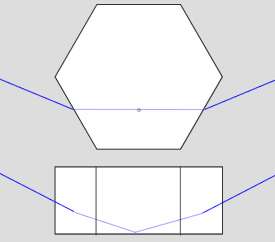
OPOD
What's New
Rays & Shadows
Water Droplets
Rainbows
Ice Halos
Contents
Crystals
Frequent Halos
Infrequent Halos
Why infrequent?
46° Halo
Supra/infralateral
Parry Arcs
Lowitz Arcs
Moilanen Arc
Kern Arc
120° Parhelia
44° Parhelia
Subhorizon Arcs
Subsun
Subparhelia
Antisolar Arcs
Pyramidal
Multiple Displays
Other Worlds
Observing Halos
HaloSim
High Atmosphere
Links & Resources
Search - Index
123456789012345678
| Subparhelia |
|
Subparhelia, subsun and lower tangent arc. Photographed by space artist Don Davis. The radiating streaks are sunlight scattered by scratches on the aircraft window. The downward slanting subparhelia are to left and right of the subsun. Above it, but still below the horizon, is a lower tangent arc. The tangent arc shape and position relative to the subhorizon arcs allowed the solar altitude to be determined as 18.5�. The matching HaloSim simulation for this altitude used a mixture of oriented plates for the subparhelia and singly oriented columns for the tangent arc. The inset shows the complete parhelia and subparhelia. They are not exact mirror images because of refraction effects within the crystals. Image �Don Davis, reproduced with permission. |
 |
Subparhelia ray paths. Rays enter and leave oriented plate crystals through side faces inclined at 60� to each other. They differ from ordinary parhelion rays in that they are totally internally reflected by the lower horizontal face. They leave the crystal in an upwards direction and so the subparhelia appear to be below the horizon. These reflections are quite sufficient to explain subparhelia. It is not necessary to invoke multiple scattering from clouds of ice crystals. |